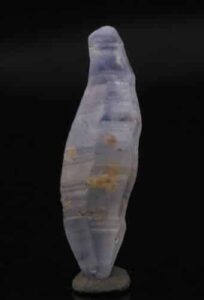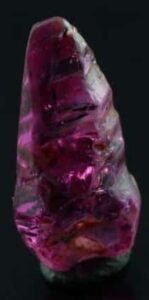Definition
The mineralogical name for Al2O3, the corundum family encompasses the gem varieties sapphire and ruby. It crystallizes in the trigonal structure and is surpassed only by diamonds in hardness.
Etymology
Whether the word ‘corundum’ originates from the Hindu ‘kurand’, ‘kuruvinda’ or ‘Kauruntaka’ isn’t clear but the fact that the word has its origin in the Hindu language appears to be clear.
History
The fact that sapphire and ruby were one and the same mineral with merely their colors differing had probably been known by miners in Sri Lanka for ages. In Europe, this wasn’t so. From Theophrastus’ classical work to de Boodt’s writings in 1609 there is no proof to be found of anyone realizing the two were one and the same mineral. In 1652 Thomas Nichols wrote a lapidary in which he hints at a relation between the two family members but doesn’t make the call. It was in 1796 when René Hauy described ruby and sapphire as a single species and over the years after that, a series of papers was published, finally uniting all corundum varieties under the single name in 1805.
Crystallography & Properties

An Example of a Monocrystalline Material.
Photo by Crystal-Treasure.com.
Corundum crystallizes in the trigonal structure and is most often found as tabular hexagonal crystals (ruby) and hexagonal bipyramids (sapphire) although other habits may be encountered as well. Twinning is quite common. Corundum is aluminum oxide and, when pure, colorless. Color in corundum is caused by impurities, the most common being chromium which causes the red in ruby and iron with titanium which is responsible for the blue in sapphire.

Image Courtesy of Crystal-Treasure.com
As said, only diamond is harder than corundum. The mineral species has been described as having no cleavage throughout history but Richard W. Hughes mentions Russian research in his book, Ruby & Sapphire that suggests cleavage exists in corundum. This was in synthetic samples of extreme purity however and it is not experienced by lapidaries working with corundum on a day-to-day basis. The world’s second hardest mineral does occasionally part along certain planes due to the exsolution of boehmite or hematite-ilmenite. The exsolved impurities cause structural weakening along the plane they exsolve in.
For further specific data on corundum see the ruby and sapphire pages.
Gemological Information for Corundum
| Color: | Colorless, Pink, Red, Orange, Yellow, Green, Blue, Purple, Black - Nearly Every Color |
| Crystal Structure: | Trigonal |
| Refractive Index: | 1.762-1.770 |
| Durability: | Very Durable |
| Hardness: | 9 |
| Family: | Corundum |
| Similar Stones: | Benitoite, Iolite, Kyanite, Tanzanite,Chrysoberyl, Garnet, Spinel, Red Tourmaline, Red Beryl, Aquamarine |
| Treatments: | Sometimes Heat Treated and/or Fracture Filled, Bulk Diffusion |
| Country of Origin: | Sri Lanka, Thailand, India, Tanzania, Australia, Myanmar, USA, Madagascar and many others |
Corundum Care
| Ultrasonic Cleaning: | Usually Safe |
| Steam Cleaning: | Usually Safe |
| Warm Soapy Water: | Safe |
| Chemical Attack: | Avoid |
| Light Sensitivity: | Stable |
| Heat Sensitivity: | May Fracture, Color Change |
Gems & Gemology: The Quarterly Journal of The Gemological Institute of America.
Corundum:
- May-June 1934, Adamantine-Spar Brown Corundum (Rarely Asterism), p. 82, 1p.
- Summer 1937, New black Star Sapphires Found, p. 98, 1p.
- Fall 1939, Lined, Foil-Backed Corundum Produces Stars and Cat’s-Eyes, p. 36, 1p.
- Winter 1944, American Synthetics Available from Linde, p. 185, 1p.
- Summer 1947, Distinction Between Corundum and Garnet, p. 435, 1p.
- Summer 1948, The 1,156 ct. Rough, and the 733 ct. Cut Black Star Sapphire of Australia, Owned by Kazanjian Bros., p. 57, 1p.
- Spring 1954, Distinguishing Between Yellow Corundum and Yellow Chrysoberyl, p. 31, 1p.
- Winter 1957, Madonna of the Star, the 545 ct. Carved Star Sapphire, Owned by Kazanjian Bros., p. 123, 1p.
- Summer 1959, X-ray Induced Yellow Sapphires and their Detection, p. 294, 1p.
- Winter 1959, A Star Sapphire Found in Finland, p. 356, 2pp.
- Summer 1960, Synthetic, Colorless Sapphire as a Diamond Substitute, p. 59, 2pp.
- Winter 1960, A Triplet to Produce a Star Corundum, p. 119, 2pp.
- Fall 1961, Corundum in Tanzania, by Webster, p. 202, 4pp.
- Winter 1961, A 30 ct. Corundum-Green by Day, Light Red-Violet by Night, p. 246, 1p.
- Fall 1962, Rubies and Sapphires from Tanzania, p. 340, 1p.
- Winter 1964, Partings in Black Star Sapphires, p. 250, 1p.
- Winter 1968, An Inclusion in Alexandrite-Like Sapphire from Montana, p. 373, 1p.
- Summer 1969, X-ray Bombarded Yellow Sapphires, p. 57, 1p.
- Summer 1969, A 277 ct. Cab Star Black Sapphire, p. 59, 1p.
- Fall 1970, A 12-Rayed Star Sapphire, p. 231, 2pp.
- Spring 1971, A Fluorescent Dye in Treated Corundum, p. 285, 1p.
- Spring 1972, A 3-Phase Inclusion in a Fine Purple Corundum, p. 11, 1p.
- Summer 1972, A Gem Alexandrite-Like Corundum, p. 43, 2pp.
- Winter 1972, Umba River Corundum of Tanzania (Ruby and Sapphire, etc.), p. 104, 2pp.
- Spring 1973, Umba River Corundum of Tanzania (Ruby and Sapphire, etc.), p. 149, 2pp.
- Fall 1974, Borax in Jewelry Repair Involving Corundum will Cause Surface Damage, p. 342, 2pp.
- Fall 1974, Tiny Round Crystals that Look Like Bubbles in Corundum, p. 343, 2pp.
- Summer 1975, A Slab with Black Sapphire Center and Altered Pinite Edge, p. 44, 2pp.
- Fall 1975, Tiny Round Crystals that Look Like Bubbles, p. 90, 2pp.
- Fall 1979, Some Sapphire Problems, and a 12-Rayed Black Star Sapphire p. 194, 3pp.
- Summer 1980, Corundum Observations and Problems, p. 315, 6pp.